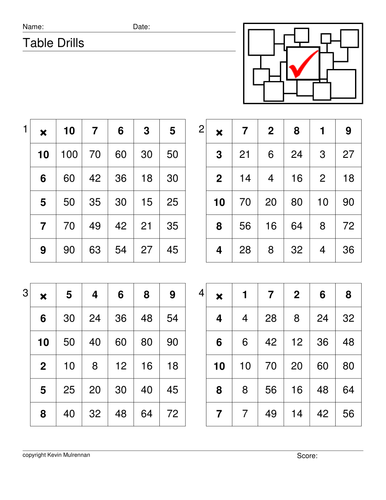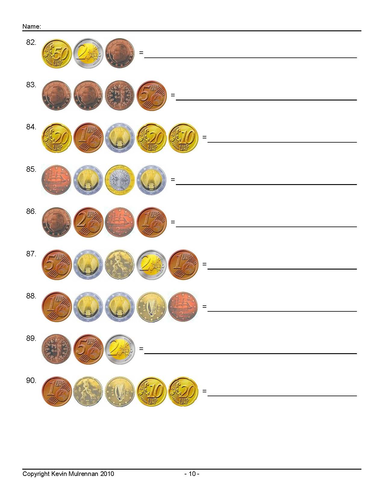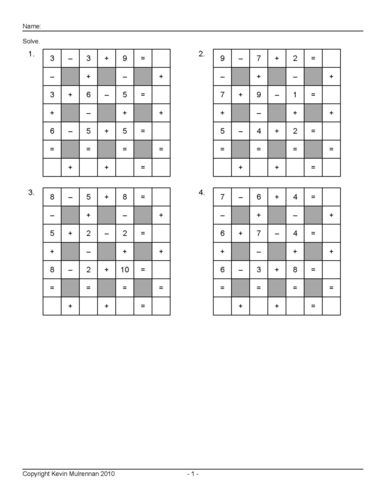404Uploads
119k+Views
40k+Downloads
Mathematics

Freebie Free 5 Worksheets Maths Shopping Arithmetic KS1 KS2 Money Counting
A freebie.
If you like these I have 100 for sale in my shop.
I have designed 5 worksheets on Money and Shopping for primary school children. I have used a variety of items, a variety of difficulty and a variety of numbers of questions per sheet. Pupils write on the sheets the total cost. e.g. a milkshake costs £2.90 a hot dog £1.65 How much would 2 milkshakes and 3 hotdogs cost? There is plenty there to reinforce the work done in the classroom. Good for extra homework or additional work for the bright ones. Answer sheets are provided for all worksheets.

Freebie Telling Time KS1 KS2 Mathematics Clocks Minutes Hours
A sheet where pupils have to put the correct times in.
If you like this, please visit my shop where you can buy a full set.

Freebie Fractions KS1 KS2 Mathematics Simplifying Mixed Fractions etc
An example freebie of my self-designed fractions sheets.
If you like this one, please take a look at my shop.
You could but half a million questions on fractions.
Or maybe ones on simplifying fractions, Mixed fractions etc.
Please look for the bundles if you are looking for great value.

Table Drills Mathematics Multiplication KS1 KS2 Maths Freebie Free
If you like this resource more available in my shop.
Fill in the gaps to get the correct multiplication answer.

Freebie Telling the Time KS1 KS2 Mathematics
A sheet with answers where pupils have to draw the hands to show the time on a small clock.
If you like this, please visit my shop where there is a more sophisticated product.

Euro Coins Worksheets KS1 KS2 Mathematics Freebie
A worksheet that pupils have to fill in. They have to add up the coins.
If you like it, please visit my shop that has an enhanced similar product.

Maths Puzzle Across Down Addition and Subtraction Puzzle Plus Answers
Great for reinforcing maths.
Across-Downs is a fun activity that reinforces addition and subtraction skills.
The object of the exercise set is to find the answer for each row and column, then use those answers to calculate the final answer in the lower right-hand corner of the puzzle.
This tests addition and subtraction.
If you like this freebie, please visit my shop which has loads of puzzles for sale. Buy the bundles for best value.

Year 5 Maths Fraction word Problems 2 Differentiated sheets Multiplication Methods
Week’s planning.
sample :
L.O. To apply understanding of multiplication facts.
Knowledge Harvest: What do chn know about multiplication and place value? I.e. when multiplying using the formal method, numbers need to be set out accurately, what methods do the children know? i.e. partitioning and formal written method.
Have 5x2x6 on the board. What is the answer? How do I work this out?
Once chn have got the answer, discuss whether it matters if the numbers are in any order.
Resources:
Dice: 1 between 2
Vocab:
Multiplication, number facts, digit, numbers, single digit,
LO: To revise calculation of multiples of 10.
Have some numbers on the board. Can chn partition them? Discuss that in 4567, the “4” has a value of “4000”. Link this to the Place Value grid (ThHTU). Remind chn that the units column is now called the “ones” column.
Have a 356 x 10 on the board. How can we work this out? Discuss different methods that the chn may come up with.
Do chn (LA) realise that you can move the digits, or will they try to use the formal method?
Clear up any misconceptions that we just add a zero or move the decimal point.
Adult to remind chn of the clue. Look at the amount of zeroes to see how many places the numbers need to be moved.

Year 5 Maths Investigations Nice Short Pithy Exercises
A series of short but interesting Maths investigations.
Nice worksheets for year 5 pupils.
Bits on tally charts and graphs.
Nice powerpoint on reading scales.

Numeracy Maths Year 4 Planning Angles Protractors Perimeter Area
Some nice planning and worksheets for year 4.
Nearly 3 mb of stuff.
sample plannimng :
Draw rectangles and measure and calculate their perimeters; find the area of rectilinear shapes drawn on a square grid by counting square Perimeter, names of 2d shapes
Addition
Total
Mentally adding 4 numbers (single and two digit) WALT – draw find the perimeter and area of a rectangle
WILF – accurate measurements
Knowledge of what perimeter is
Knowing what area is and how to calculate
Good mental methods
Children will know how to find the perimeter of a rectangle. Pupils will also need to be reminded of units of measure that we may need to use – mm/cm.
Target maths P82 In real life situations, when would you need to know the perimeter of something? What unit of measurement might we need for the suggested things?

Back to School Year 5 Autumn Term Mathematics 4 Groups
Some nice planning.
In 4 groups so lots of differentation.
Example :
L.O
To order positive and negative numbers and find differences between numbers
(not set) Dividing by 10,100 and 1000 quick fire questions Must: I can order sets of negative numbers Share with the children an image of a thermometer, what is it used for? What do we know about temperature? Children to mark on the thermometer temperatures they know ie body temp, boiling point etc.
Can temperature go below zero? What do we call those numbers?
Share with the children -15, -2, -20, -9 and -21. Where on the thermometer do these go? Discuss smallest to biggest ordering, which number is smaller/larger.
In pairs order a set of numbers (+ and -) L/A
Children to order sets of negative numbers. Moving on to reading temperature problems.
(activity 1-2 on pg6 NPM 6a)
Number lines/thermometer to support?

Spring Year 6 Maths Planning 13 weeks 36 page pdf
36 page pdf.
Maths for each of 13 weeks.
sample :
LO: To reflect shapes across a horizontal or vertical mirror line.
KEY QUESTION: DO I NEED TO USE A MIRROR TO REFLECT A 2D SHAPE?
Review the term reflection with the children. How would the children reflect a simple shape like a square across a mirror line? Show the children a more complex shape. How would the children go about reflecting this shape?
Explore the use of a mirror using a large version of a shape on the working wall. If you hadn’t got access to a mirror, how would you go reflect the shape?
Focus on process of identifying vertices within shapes, counting to the mirror line.
DS: Supports Triangles during teaching.
AG: Supports Squares during teaching.
LO: To draw and reflect a shape across a 45 degree mirror line.
Show the children a shape and have them model how to reflect across a vertical and horizontal mirror line. Show them a mirror line that is set at 45 degrees. Discuss possible strategies for carrying out the task of reflecting across the mirror line. Make sure the children stay on the grid lines and follow to the mirror line, then away from the mirror line to make a right angle.
MW: target high Focus Children within teaching. Check during lesson.
LO: To reflect a shape that crossing a 45˚ mirror line.
KEY QUESTION: HOW CAN I REFLECT A SHAPE THAT CROSSES THE MIRROR LINE?
Address misconceptions from previous lesson. Give the children an enlarged version of a triangle that crosses a diagonal mirror line. As a class, identify way in which the shape can be reflected across the mirror line. Take each point and reflect across a perpendicular set of gridlines. Model the use of start and end points. Whatever is in the upper part of the mirror line needs to be in the lower, vice versa.
DS: Supports triangles during lesson.
AG: Supports Circles during lesson.

Year 1 Maths English Planning
Planning for English and Maths. 56 files.
sample:
Text:
This is the bear and the scary night
Genres covered in this unit:
Narrative SPAG focus:
Monday: spelling patterns
Tuesday: use and to join clauses
Wednesday: high frequency words
Thursday: high frequency words
Friday: time connectives
Key teaching input/texts/questions/
clips etc Steps to Success
Read the story This is the Bear and the scary night
Discuss character, setting, key events etc…
Discuss what happened in the beginning, middle and end of the story. Explain to the children that this week they are going to write their own story similar to the bear and the scary night.
Ask children to describe their character to their partner (can be their favourite toy or the teddy they bought into school on Friday).
Ask children to share their ideas about their story.
What is the setting?
What are the characters doing?
What is the problem?
How are the characters feeling?
How does your story end?
Mild: describe your main character
Spicy: share your ideas with your partner
Hot: listen attentively to your partner
Extra Hot: Act out key events from your story
LA Activities MA Activities HA Activities
Read to Write
Mrs Preston Phonics
Mrs Simpson Talk for writing and act out their story
Photos for books
Resources: The bear and the scary night book, cards with questions
Give 3 minutes for children to recap their story.
Who is their main character?
What happens at the beginning, middle and end of the story?
Model how to put key ideas onto their plan.
Steps to Success
Mild: recap your story with your partner
Spicy: Identify the beginning, middle and end of your story
Hot: Write key ideas onto your story plan for the beginning, middle and end.
Extra Hot: Check your partner’s plan is sequenced correctly

Back to School Morning Resources Powerpoint Maths Year 4 Year 5
Some material that can be displayed on the board as they enter for registration.
7 to 10 simple questions per day
Two weeks worth.
sample ;
A school bag could weight about:
2 metres, 2 centimetres, 2 kilometres, or 2
kilograms?
The length of a bed measures about:
2 kilos, 2 metres 2 inches or 12 metres?
The height of a school building would be measured in:
centimetres, litres, kilometres, metres?
How many mms in 25cms?
How many strips of 10cm could you cut from 2 metres
of tape?
In the year 3 classroom there are 4 pots with 5 crayons
in each pot. How many crayons are there altogether?
Jodie thinks of a number and doubles it. The answer
is 30. What was the number Jodie thought of?
Double 7 and add 2.
Draw a square and shade ¾ of it.
A trip to the swimming baths costs 50p per child.
How much will it cost for 4 children?

Back to School Morning Resources Powerpoint Maths Year 4 Year 5 Set 2
Some material that can be displayed on the board as they enter for registration.
Powerpoint.
10 simple questions per day
Three weeks worth. Watermark not on full product
sample ;
Double 24.
Half of 28 is 14. What is ¼ of 28?
What is an apple likely to weigh:
1g, 10g, 100g, 1kg, 10kg?
A garden path is 10m long. Half of it is weeded, how
much is still to be weeded?
How many grams are there in 1kg?
How many 10’s are there in 265?
How many 100’s are there in 265?
Which of the following are even?
12, 9, 6, 14, 17, 5.
Read these numbers to your partner 562, 784, 90, 106.
Write these numbers in figures, two hundred and seven, six hundred and twenty six, fifty.

Back To School Autumn Short Term Lesson Plans Reception to Year 6
14 weeks of short term plans
Great for cutting and pasting into your own personal school timetable.
I’ve included a sample week in the visible upload. The zip contains the lot.
sample year 2. Register Activity
Chn finish work from Meet Your New Teacher day.
9am: Input: Welcome the children to their first day of year 2! Talk about how we were feeling before coming into school, did we get very much sleep last night? Share with the children how you were feeling too!
Introduce the chn to the text of the week: First day jitters by Julia Danneberg. Read the story together and discuss the twist at the end. (Ask questions throughout)
T focus for morning: x2 groups of 6
L.O. To use features of a non-chronological report
W.I.L.F
I can…
Include a heading
Use subheadings to organize my writing
Talk about the difference between facts and fiction
(All about me) Chn create a 3D profile, including a self-portrait drawing of their head, to be used for display. Chn complete section boxes all about their family, friends, hobbies etc. Cut out the sections and arrange them inside the folded top. Put together the body parts on colored backing card, ready for the head to be attached later. Label with name sticker.
9am: Input: Quickly recap the story for this week and remind ourselves of the main character, how she was feeling and why?
Introduce class bear, explain that he was also feeling very nervous about meeting new chn and starting year 2. Display a page from (bear’s) diary, ask the chn to highlight the adjectives they can see. (perform an action when they hear an adjective word)
T to highlight them in a colour as they read.
Explain the independent challenge is to match up the adjective words to the different emotion cards.
T focus for morning: x2 groups of 6
L.O. To use adjectives
W.I.L.F
I can…
Use capital letters and full stops
Use first person
Use commas between adjectives
Check my sentences make sense
(Writing it in the present tense) Chn to write a short diary entry about how they were feeling the night before they came back to school, include adjectives to describe how you were feeling.
*Have Monday’s 3D profiles out on a table to finish off.
TA focus for first thing: To assess SPP chn against current targets, make notes and set up folders for works to begin.

Maths year 6 12 Powerpoints 19 Word Files Time Area addition subtraction
12 Great powerpoints and associated word documents.
Ideal for entry into class or revision.
eaxample Order these integers from smallest to largest:
15, 9, 3, 108, 74, 203
93, 105, 99, 76, 54, 1, 205
3733, 408, 4080, 102, 97, 313, 537, 999.

Year 6 Maths Mean Median Mode Averages Range
A couple of nice lessons on these Maths topics.
Plus a little bit of spelling and formal and impersonal lessons.
sample:
LO: To state mathematical averages. (Hexagons and Pentagons)
For each of these questions, state the median, mode and mean average. Copy the data into your book. The layout is modelled in the first question.
MUST:
Maths Assessment Scores: 14 12 13 9 14 14
Mode:
Median:
Mean:
Football team Goals: 0 4 8 2 2 2 0 4 2 4
Visits to the seaside this year: 0 6 4 12 2 4 8 6 10 8
SHOULD:
4. Science Assessment Scores: 22 22 10 30 36
Hockey Team Goals: 3 6 12 0 0 0 9 12 10 6
Visits to Cinema in a year: 12 16 8 24 4 12 8 16 12 4
CHALLENGE
8. Spelling Scores: 6 7 9 2 4 5 0 4 1 2 6 5 5 5 8 9
Number in Family: 4 8 4 10 12 6 4 6 8 6 9 7
LO: To state mathematical averages. (Hexagons and Pentagons)
For each of these questions, state the median, mode and mean average. Copy the data into your book. The layout is modelled in the first question.
MUST:
. Maths Assessment Scores: 14 12 13 9 14 14
Mode:
Median:
Mean:

1000 Questions Counting Tables KS2 Fill in the Squares Mathematics
1000 questions where pupils have to fill in a counting square.
e.g. count by 2 from 8 to 56
All answers provided.
Good for drilling or time filling.
Each square is 5 by 5.

1000 questions Mathematics KS2 Multiple Addends 2 Digit Numbers
1000 questions Mathematics KS2 Multiple Addends 2 Digit Numbers
Pupils have to add up three 2 digit numbers.
All answers provided.




















